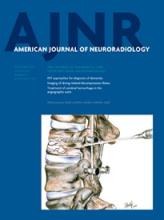Research ArticleBrain
Open Access
Whole-Brain Diffusion Tensor Imaging in Correlation to Visual-Evoked Potentials in Multiple Sclerosis: A Tract-Based Spatial Statistics Analysis
D. Lobsien, B. Ettrich, K. Sotiriou, J. Classen, F. Then Bergh and K.-T. Hoffmann
American Journal of Neuroradiology November 2014, 35 (11) 2076-2081; DOI: https://doi.org/10.3174/ajnr.A4034
D. Lobsien
aFrom the Departments of Neuroradiology (D.L., K.-T.H., K.S.)
B. Ettrich
bNeurology (B.E., F.T.B., K.S., J.C.), University and University Hospital Leipzig, Leipzig, Germany.
K. Sotiriou
aFrom the Departments of Neuroradiology (D.L., K.-T.H., K.S.)
bNeurology (B.E., F.T.B., K.S., J.C.), University and University Hospital Leipzig, Leipzig, Germany.
J. Classen
bNeurology (B.E., F.T.B., K.S., J.C.), University and University Hospital Leipzig, Leipzig, Germany.
F. Then Bergh
bNeurology (B.E., F.T.B., K.S., J.C.), University and University Hospital Leipzig, Leipzig, Germany.
K.-T. Hoffmann
aFrom the Departments of Neuroradiology (D.L., K.-T.H., K.S.)

References
- 1.↵
- Ciccarelli O,
- Toosy AT,
- Hickman SJ, et al
- 2.↵
- 3.↵
- 4.↵
- Budde MD,
- Xie M,
- Cross AH, et al
- 5.↵
- Song SK,
- Yoshino J,
- Le TQ, et al
- 6.↵
- Halliday AM,
- McDonald WI,
- Mushin J
- 7.↵
- 8.↵
- Weinstock-Guttman B,
- Baier M,
- Stockton R, et al
- 9.↵
- 10.↵
- Plant GT,
- Kermode AG,
- Turano G, et al
- 11.↵
- 12.↵
- Kantorová E,
- Ziak P,
- Kurca E, et al
- 13.↵
- Smith SM,
- Jenkinson M,
- Johansen-Berg H, et al
- 14.↵
- 15.↵
- 16.↵
- 17.↵
- Klawiter EC,
- Schmidt RE,
- Trinkaus K, et al
- 18.↵
- Schmierer K,
- Wheeler-Kingshott CA,
- Boulby PA, et al
- 19.↵
- Liu Y,
- Duan Y,
- He Y, et al
- 20.↵
- 21.↵
- Roosendaal SD,
- Geurts JJ,
- Vrenken H, et al
- 22.↵
- Kolbe SC,
- Marriott M,
- Walt Av, et al
- 23.↵
- Jasse L,
- Vukusic S,
- Durand-Dubief F, et al
- 24.↵
- 25.↵
- Gaffan EA,
- Bannerman DM,
- Warburton EC, et al
- 26.↵
- Thomas AG,
- Koumellis P,
- Dineen RA
- 27.↵
- Minagar A,
- Barnett MH,
- Benedict RH, et al
- 28.↵
In this issue
American Journal of Neuroradiology
Vol. 35, Issue 11
1 Nov 2014
Advertisement
D. Lobsien, B. Ettrich, K. Sotiriou, J. Classen, F. Then Bergh, K.-T. Hoffmann
Whole-Brain Diffusion Tensor Imaging in Correlation to Visual-Evoked Potentials in Multiple Sclerosis: A Tract-Based Spatial Statistics Analysis
American Journal of Neuroradiology Nov 2014, 35 (11) 2076-2081; DOI: 10.3174/ajnr.A4034
0 Responses
Whole-Brain Diffusion Tensor Imaging in Correlation to Visual-Evoked Potentials in Multiple Sclerosis: A Tract-Based Spatial Statistics Analysis
D. Lobsien, B. Ettrich, K. Sotiriou, J. Classen, F. Then Bergh, K.-T. Hoffmann
American Journal of Neuroradiology Nov 2014, 35 (11) 2076-2081; DOI: 10.3174/ajnr.A4034
Jump to section
Related Articles
- No related articles found.
Cited By...
- Diffusion-weighted Imaging And Retinal Oximetry Predict Functional Outcome After The First Episode Of Optic Neuritis
- Development of the Alpha Rhythm Is Linked to Visual White Matter Pathways and Visual Detection Performance
- Development of the alpha rhythm is linked to visual white matter pathways and visual detection performance
- Development of the visual white matter pathways mediates development of electrophysiological responses in visual cortex
- Clinical evoked potentials in neurology: a review of techniques and indications
This article has not yet been cited by articles in journals that are participating in Crossref Cited-by Linking.
More in this TOC Section
Similar Articles
Advertisement











